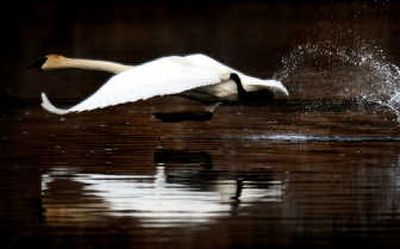Turnbull program teaches children about wildlife

A sure sign of spring is the return of waterfowl to Turnbull National Wildlife Refuge south of Cheney.
Just as telling are the kids who flock to the 16,000-acre preserve as the days get warmer.
Earlier this month, dozens of school-age children from Post Falls spent an afternoon immersed in the abundance of life found in the wetlands at Turnbull.
Heavier amounts of rain and snow over the past months have recharged refuge wetlands, reversing several years of drier conditions and replenishing the marshy areas where waterfowl nest. Visitors this year are likely to see plenty of wildlife.
“It’s really fun,” said Calvin Haagenson, 12, who was part of a spring break camp organized through Post Falls’ city parks and recreation department. “We get to look at wildlife and we get to go search through the swamp.”
Nearly 8,000 children visit the refuge each year as part of an ongoing environmental education program that has served the Spokane region for a quarter century.
“It’s really important to get these kids out here and connected with nature,” said Nancy Curry, refuge manager. “For some of these kids this is the first time they’ve gotten out into this environment.”
It was apparent the children enjoyed themselves. They used nets to dip into the shallows along a stand of cattails to retrieve various invertebrates or small fishes. “We found it! Look it!” one girl exclaimed as the net came up with some critters in it.
“You can actually do things with the bugs,” said Rosalyn Crysler, 9.
Gretchen Mallari, who is working at the refuge through the AmeriCorps service program, said the refuge holds up to three classes a day, with nearly every session booked from now until school is out in June. “We are completely packed for the month of May,” she said.
Curry said the U.S. Fish and Wildlife Service recognizes the importance of getting schoolchildren into the outdoor environment, to build interest and understanding in environmental preservation and to encourage the healthy aspects of exercise and fresh air.
The educational program has several components, including age-specific themed courses, environmental training for teachers and fall field trips.
The refuge occupies an important ecological spot on a landscape known as the channeled scablands. Glacial floods 15,000 years ago swept across the terrain, leaving depressions that formed a series of wetlands in the transition zone between the drier Columbia Basin and the forested mountains to the east.
Much of the area south of Cheney was drained by settlers last century in attempt to farm the wetlands, but some of the drained land failed to produce hay crops. In 1937, the refuge was established under the leadership of one of the settlers, Cyrus Turnbull.
Curry said the landscape, if fully restored, has the potential to be one of the most productive duck and bird breeding grounds in the country.
Relatively good water conditions from 1995 to 2000 saw the number of breeding pairs of waterfowl at the refuge increase from a low of about 750 in 1992 to nearly 2,500 in 1999. Drier conditions since 2000 caused the numbers to decline again to about 1,000 in 2004. The pairs have slowly increased in the years since, said Mike Rule, biologist at the refuge.
It usually takes about two years of good conditions for waterfowl numbers to increase following a drought. About 1,250 pairs of breeding ducks were counted in 2007.
The estimated number of breeding pairs across North America has fluctuated as well with the numbers hovering in the 30 million to 40 million range from the late 1990s through the early part of this decade, according to a 2004 population status report from the U.S. Fish and Wildlife Service.
Among the birds that have arrived at Turnbull this spring is a pair of trumpeter swans, including one male that apparently has been coming back to Turnbull for about 35 years. He is paired with a female currently, but it’s not clear whether they will attempt to nest, Curry said. They can be seen at the main ponds adjacent to Smith Road near the refuge headquarters.
A comprehensive conservation plan adopted for Turnbull last year establishes a stewardship area of 12,000 acres around the refuge and calls for potential habitat acquisitions either through purchases or leases on the lands adjacent to the refuge.
Refuge managers have been working with Ducks Unlimited, the Inland Northwest Land Trust, the state Department of Fish and Wildlife and other organizations or agencies to expand wildlife habitat.
Purchases are made only from willing sellers, Curry said.
A 200-acre drained wetland is being acquired at Curtis and Cheney-Spangle roads. The Nature Conservancy helped with acquisitions of 80 acres on Phileo Lake several years ago and 126 acres east of the refuge on Cheney-Spangle Road, she said. A separate conservation easement is being sought from a private landowner who is restoring a wetland as part of a potential home development project.
Grant funds have been made available from the North American Wetlands Conservation Act.
In addition, the wetlands create habitat for migrating songbirds.